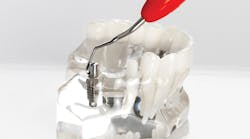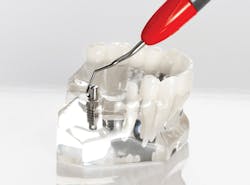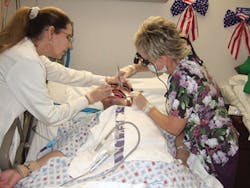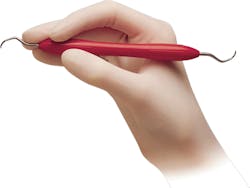Author notes how design of instruments addresses implant safety and ergonomics
BY Dianne L. Sefo, RDH, BA
Since the 1960s, the placement of dental implants has increased and is now an acceptable standard of care for tooth replacement.1 Concurrently, as implants become more common, the prevention of peri-implant diseases has become particularly important in dentistry. The prevalence of peri-implant mucositis is estimated to be 43% and peri-implantitis 22%.2
The tissue around dental implants react to bacteria similarly to the tissue around natural teeth. The longevity of implants is dependent on appropriate tissue maintenance, which requires hand instrumentation. The shape of implant abutments and prosthesis can make it challenging to reach around the structure to remove bacterial plaque, calculus, or residual cement, especially if the gingival margin is tight.
There is also an increased risk for work-related muscular skeletal disorders (WMSDs) for the clinician due to the repetitive hand motions that occur during instrumentation. It is important for the dental hygienist to be able to properly maintain a healthy implant environment while preventing WMSDs by choosing the right instruments for dental implant care.
Implant design, location, and clinical situations can make it difficult for adequate deposit removal around the dental implant surface.3 The LM-ErgoMix instruments with titanium tips are ideal for cleaning the implant surface effectively with their slim curved tips to access tight and challenging areas. A range of implant surfaces and various tissue conditions can be found surrounding the implant. The exchangeable tips that twist on and off provide an economical alternative to have numerous working ends easily available for the several conditions found around a dental implant when removing bacterial biofilm, calculus deposits and residual cement. Effective removal of these deposits are essential in maintaining the long-term success of the implant.
Ideally, instruments for cleaning dental implants should effectively remove deposits and cause minimal damage to the abutment. Altering the titanium surface can negatively affect its biocompatibility. Scaling procedures with curettes have been shown to affect the cell adherence to the implant surface.5 Both stainless steel and titanium-alloy curettes showed fewer attached cells on the scanning electron microscopy (SEM) with the stainless steel curette instrumented surfaces producing the greatest reduction in cell attachment. Titanium has shown to be an acceptable material for implant scalers as it does not yield the same surface alterations that metal curettes and ultrasonic devices with metal tips have caused.6
The LM titanium implant instruments are made of a soft titanium alloy that are safe for implant abutments. However, they still offer the same tactile sensitivity that is comparable to steel instruments.
Addressing ergonomic concerns
The use of dental instruments requires precision and a high level of pinch force, which increases the risk for carpel tunnel syndrome (CTS), a type of WMSD that is prevalent among dental hygienists.7-10 The most commonly reported symptoms include pain, tingling, and numbness in the hands.11
Ergonomically designed dental instruments can reduce the prevalence of WMSDs among dental professionals by decreasing the effect of the pinch grasp and creating a neutral posture.12 Various literature have suggested to alternate instrument handle sizes, use instruments with larger diameter handles, use lightweight instruments, use instruments with rubber coating or padding, adapt the shape and texture of the handle, and use a variety of handles throughout each appointment.11, 13-16
It is optimal for the diameter of dental instruments to be at least 10mm, weigh 15g or less, and have padding to decrease muscle activities.17 LM-ErgoMix instrument handles are 12.5mm in diameter, light weight, and have textured silicone grips. Texture increases static friction between the fingers and the handle, which results in a reduced pinch force.18-21
Dental hygienists in particular are at risk for WMSDs due to the repetitive activity done on every patient throughout each day. A variety of hand instruments are available for the maintenance of dental implants. It is the responsibility of the dental hygienist to determine the appropriateness of the instrument used to be able to gain access to the dental implant for proper removal of deposits and prevent damage to the abutment surface while reducing the risk of injury to self. The LM-ErgoMix
instruments with titanium tips provide a unique balance of ergonomics, functionality and design. RDH
Dianne L. Sefo, RDH, BA, is a clinical instructor and pre-clinical coordinator at New York University. She participates in didactic and clinical dental hygiene education. Dianne has previously worked as a dental hygiene educator at Monroe Community College and Concorde Career College - San Diego. She has also held positions at various private practices in New York and Southern California. In addition to her teaching and clinical work, she has contributed to various publications pertaining to the advancement of the standard of care in evidence-based dental hygiene therapy.
References
1. Albrektsson T, Wennerberg A. The impact of oral implants - past and future, 1966-2042. J Can Dent Assoc. 2005; 71(5): 327.
2. Derks J, Tomasi C. Peri-implant health and disease. A systematic review of current epidemiology. J Clin Periodontol. 2014 Dec 12. doi: 10.1111/jcpe.12334.
3. Persson GR, Samuelsson E, Lindahl C, Renvert S. Mechanical non-surgical treatment of peri-implantitis: A single-blinded randomized longitudinal clinical study. II Microbiological results. J Clin Periodontol. 2010; 37(6): 563-573.
4. Hultin M, Komiyamma A, Klinge B. Supportive therapy and the longevity of dental implants: a systematic review of the literature. Clin Oral Impl Res. 2007 Jun; 18(3): 50-62.
5. Dmytiyk JJ, Fox SC, Moraiarty JD. The effects of scaling titanium implant surfaces with metal and plastic instruments on cell attachment. J Periodont. 1990 Aug; 61(8): 491-496.
6. Louropoulou A, Slot D, Van der Weijden F. Titanium surface alterations following the use of different mechanical instruments: a systematic review. Clin Oral Implants Res. 2012 Jun; 23(6): 643-658.
7. Macdonald G, Robertson MM, and Erickson JA. Carpal tunnel syndrome among California dental hygienists. Dent Hyg (Chic). 1988; 62: 322-327.
8. Liss GM, Jesin E, Kusiak RA, and White P. Musculoskeletal problems among Ontario dental hygienists. Am J Ind Med. 1995; 28: 521-540.
9. Lalumandier JA, McPhee SD, Riddle S, Shulman JD, and Daigle WW. Carpal tunnel syndrome: effect on Army dental personnel. Mil Med. 2000; 165: 372-378.
10. Lalumandier JA, McPhee SD. Prevalence and risk factors of hand problems and carpal tunnel syndrome among dental hygienists. J Dent Hyg. 2001; 75: 130-134.
11. Michalak-Turcotte C. Controlling dental hygiene work related musculoskeletal disorders: the ergonomic process, J Dent Hyg. 2000; 74: 41-48.
12. Dong H, Barr A, Loomer P, Laroche C, Young E, Rempel D. The effects of periodontal instrument hand design on hand muscle load and pinch force. JADA. 2006 Aug; 137(8): 1123-1130.
13. Horstman SW, Horstman BC, HorstmanFS. Ergonomic risk factors associated with the practice of dental hygiene: a preliminary study. Prof Safety. 1997; 42: 49-53.
14. Liskiewicz ST, Kerschbaum WE. Cumulative trauma disorders: an ergonomic approach for prevention. J Dent Hyg. 1997; 71: 162-167.
15. Stentz TL, Riley MW, Harn SA, Sposato RC, Stockstill J, Harn JA. Upper extremity altered sensations in dental hygienists. Int J Ind Ergon. 1994; 13: 107-112.
16. Van der Beek AJ, Frings-Dresen MH. Assessment of mechanical exposure in ergonomic epidemiology. J Occup Environ Med. 1998; 55: 291-299.
17. Simmer-Beck M, Branson BG. An evidence-based review of ergonomic feature of dental hygiene instruments. Work. 2010; 35(4): 477-485.
18. Bobjer O, Johansson S, Piguet S. Friction between hand and handle. Effects of oil and lard on textured and non-textured surfaces; perception of discomfort. Appl Ergo. 1993 Jun; 24: 190-202.
19. Fredrick LJ, Armstrong TJ. Effect of friction and load on pinch force in a hand transfer task. Ergo. 1995 Dec; 38: 2447-2454.
20. Johannson RS, Westline G. Roles of glabrous skin receptors and sensorimotor memory in automatic control of precision grip when lifting rougher or more slippery objects. Exp Brain Res. 1984; 56(3): 141-154.
21. Laroche C, Barr A, Dong H, Rempel D. Effect of dental tool surface texture and material on static friction with a wet gloved fingertip. J Biomech. 2007; 40(3): 697-701.









